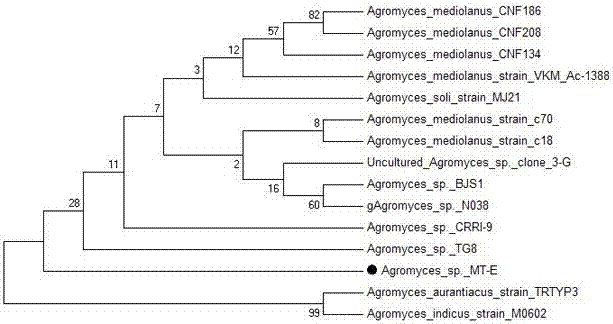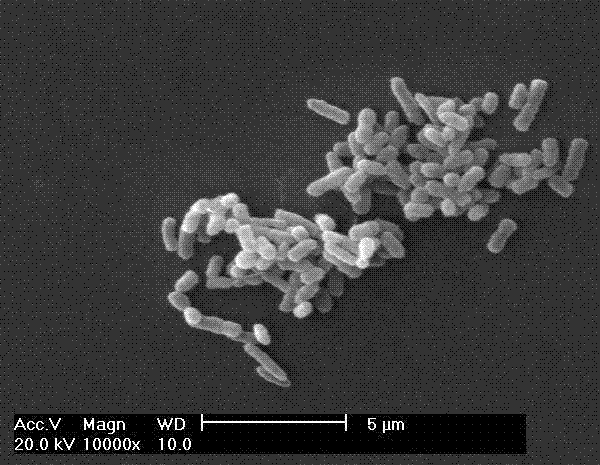A strain of Agromyces sp. MT‑E that can simultaneously degrade multiple phthalates
A soil mold, MT-E technology, applied in the field of biological treatment of environmental pollutants, can solve problems such as degradable phthalates that have not yet been seen, and achieve the effects of enriching the germplasm resource pool, easy cultivation and strong adaptability
- Summary
- Abstract
- Description
- Claims
- Application Information
AI Technical Summary
Problems solved by technology
Method used
Image
Examples
Embodiment 1
[0024] The isolation and identification of embodiment 1 bacterial strain
[0025] Collect farmland soil that has been used in plastic greenhouses all year round, weigh 5 g of fresh soil samples into a 150 mL Erlenmeyer flask containing 50 mL of sterile water, incubate at 30°C and 150 rpm for 3 days, then add 5 mL of sludge suspension to 100 mL of DBP and DEHP (50 mg / L, respectively) in MSM medium. After being cultured at 30°C and 150 rpm for 7 days, the inoculum was continuously enriched and transferred 10 times with an inoculum size of 1 mL each time, and the content of PAEs in the medium was correspondingly increased to 1000 mg / L. Then the 10 times acclimatized culture solution was diluted 10 3 ~10 5 Spread on LB solid plates and incubate upside down at 30°C for 1-3 days. After a single colony grows on the plate, pick a single colony and streak it several times for purification, and obtain a strain of bacteria, numbered MT-E. Then the strains were inoculated on LB solid ...
Embodiment 2
[0032] Embodiment 2 soil mold ( Agromyces sp.) Degradation effect of strain MT-E on DBP and DEHP
[0033] S1. Preparation of bacterial suspension: Inoculate the purified MT-E strain into 10 mL of LB liquid medium for overnight activation to the logarithmic phase, collect the bacterial cells by centrifugation at 5000 rpm for 10 min, and wash the bacteria 3 times with PBS After resuspension, adjust OD 600 nm =0.8 as bacterial suspension.
[0034] S2. Inoculate 1 mL of the above-mentioned bacterial suspension into 100 mL of MSM culture solution containing 200 mg / L of DBP and DEHP (each containing 200 mg / L), and use no inoculation as a negative control, and adjust the pH to 7.5. Set of three repetitions. Incubate in a constant temperature shaker at 30°C and 150 rpm for 7 days, take samples and extract samples at 0, 1, 3, 5, and 7 days respectively, and measure the degradation of DBP and DEHP in the samples by GC / MS. Determination of bacterial growth OD at each time point 600...
Embodiment 3
[0039] The remediation effect of embodiment 3 bacterial strain MT-E to DBP and DEHP polluted soil
[0040] S1. Preparation of test soil: The soil is paddy soil from the farm of South China Agricultural University. After air-drying, pass through a 60-mesh sieve with a pH of 6.7. Adjust the steamed water to the field water holding capacity (about 30%), and age in the dark for 15 days.
[0041] S2. Weigh the above-mentioned 100 mg kg -1 Put 200 g of DBP and DEHP soil in a Erlenmeyer flask, add 50 mL of bacterial suspension to the soil, and mix well. In addition, the treatment without bacteria was used as the control group. Adjust the soil to the field water holding capacity (about 30% water content), culture in a 30°C incubator in the dark, take samples and extract regularly at 0, 2, 4, 6, 8, and 10 days, and then conduct GC / MS Determination of DBP and DEHP residues in soil.
[0042] Sample extraction: Weigh 1 g of air-dried and ground soil sample into a 35 mL glass centrifuge...
PUM
 Login to View More
Login to View More Abstract
Description
Claims
Application Information
 Login to View More
Login to View More - R&D
- Intellectual Property
- Life Sciences
- Materials
- Tech Scout
- Unparalleled Data Quality
- Higher Quality Content
- 60% Fewer Hallucinations
Browse by: Latest US Patents, China's latest patents, Technical Efficacy Thesaurus, Application Domain, Technology Topic, Popular Technical Reports.
© 2025 PatSnap. All rights reserved.Legal|Privacy policy|Modern Slavery Act Transparency Statement|Sitemap|About US| Contact US: help@patsnap.com



